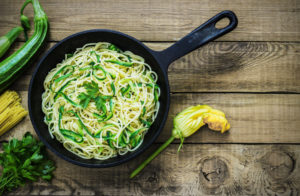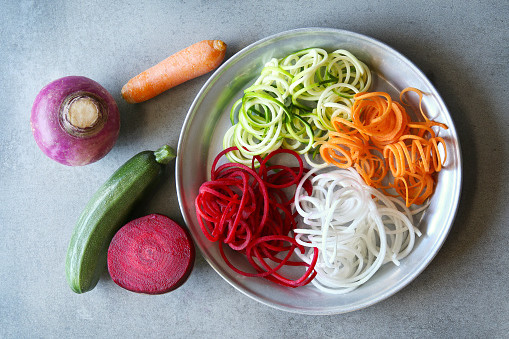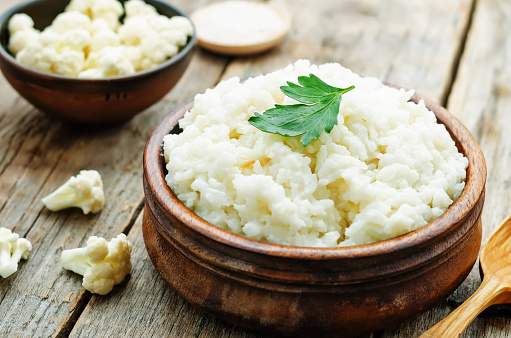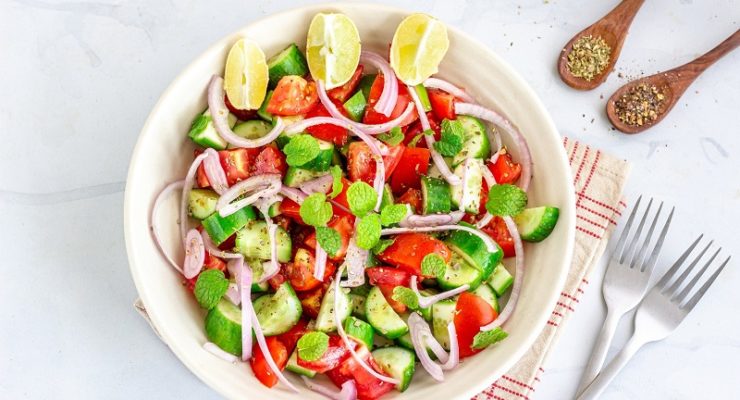How to Eat More Without Gaining Weight: Volumetrics Diet Explained
Article posted in: Diet & Nutrition
What if you could eat more food, but lose weight? Sounds like a fantasy or some snake oil sold on late-night TV, but it’s really possible. The idea is called volumetrics, and the key word is volume: By eating foods that have fewer calories but are higher in volume, you can eat more food while consuming less overall energy.
Foods that are water-rich, like many vegetables, take up a lot more space than more calorie-dense fare, so you fill up on better foods. And it works! In a study from 2007, researchers had participants eat a low-calorie broth before their meal. They ate 20 percent fewer calories from their entrée than those who didn’t have the soup.
When women in another study added water-rich foods to their diet plan, they lost 30 percent more weight during the first six months of dieting than those who didn’t focus on adding water-rich foods to their plates.
Non-starchy vegetables are a great way to add water-rich foods to your diet. These lower-carb vegetables, like leafy greens, cucumbers and certain squashes, aren’t just rich in water to fill you up, but they also have fiber—a nutrient that controls the speed of digestion so you feel fuller, longer.
Add in the vitamin and mineral benefits of these low-cal foods, and it’s no wonder Nutrisystem plans recommend you eat at least four servings of non-starchy vegetables per day—and as many as you want overall, because they’re unlimited on the program.
Here are four ways to use unlimited vegetables to eat more without gaining any weight:
1. Pump up pasta dishes with spiralized zucchini.
The real proper portion of pasta is surprisingly small—just a half-cup of the cooked stuff! If you’re used to heaping piles of spaghetti, but don’t want to look like you are, use veggies to enable you to eat more. By using a spiralizer, a kitchen tool that resembles a pencil sharpener and turns veggies into “noodles,” you can create perfect noodle-like textures that add volume without the carbs (Ready to give this a whirl? Check out these awesome spiralizer recipes!)

Zucchini noodles have a nearly perfect texture once spiralized, and can make a great addition—or replacement—for spaghetti with red sauces. Just don’t overcook them: Zucchini noodles need just a minute in boiling water to take on that spaghetti feel.
The zucchini won’t just lower the calories in your pasta dish, though. Zucchinis add nutrients your body needs and craves, like potassium: You might be surprised to know that a medium zucchini actually has more potassium than a medium-sized banana—and has just 33 calories compared to more than 100 calories for the carby fruit.
2. Replace rice with cauliflower—in soups, stuffed peppers and more.
Soups are already water-rich, and can help with weight loss: In another study of soup, researchers found that when they gave dieters either a chicken casserole or a chicken rice soup before a meal, the soup eaters ended up eating less once the main course arrived. And here’s the crazy part: The casserole and soup had the exact same ingredients in the exact same amounts—the soup just had more water.
You could reduce the calories in a chicken rice soup even further and actually eat more of it by replacing the grains with cauliflower rice: By running raw cauliflower florets through the food processor, or by simply using a cheese grater, the white veggie turns into tiny pieces that get fluffy and delicious like rice, but with far fewer calories. While 100 grams of rice has 370 calories, the same amount of cauliflower has just 25 calories. It also brings some calcium along: A small head of cauliflower has about half the calcium of 100 grams of skim milk—not a ton, but some bone-boosting power from a veggie.
To add volume to any soup, add a few big tablespoons of uncooked riced cauliflower—the hot broth will quickly cook and incorporate the veggie into your soup. Or use it as an additive or replacement for rice in stuffed peppers or beans and rice dishes: You don’t need water to cook it. Heat a skillet over medium-high heat and spray with zero-calorie nonstick spray. Add the cauliflower and stir until it’s softened, about three minutes. Add to your normal dishes and enjoy!
3. Add cauliflower or broccoli to your mashed potatoes.
Some people like to make their potato pile bigger with cauliflower—it mashes well after a few minutes of boiling, and like the potatoes, it’s white. But if you’re feeling adventurous, add some flavor and volume to your side of mash with broccoli.


Add a big head of broccoli to a pot of boiling water, and let it cook for five to eight minutes, until it starts to get a little mushy. Use a food processor or mixer to mash the broccoli, and use it to volumize your mashed potatoes—whether they’re homemade, or you’re mixing up an existing meal like Nutrisystem’s Loaded Mashed Potato. Because it’s unlimited, you can as much broccoli as you want to the spuds to add volume to your meal, all while getting Vitamin B, iron, and more than five grams of filling fiber per cup from the little green trees.
4. Add vegetable nutrition to a chocolate or berry smoothie—and never know it’s there.
A small amount of kale or spinach added to a chocolate or berry smoothie may not sound that appetizing, but here’s the cool part: You’ll add filling fiber and volume to the drink, but the strong berry or chocolate flavor will mask the taste of the greens, so you won’t even know they’re in there. And they can also make your smoothie an immunity booster: One serving of kale has more than 100 percent of your daily Vitamin C, which has been shown to ease allergy symptoms, as well as Vitamin A, which scientists also think helps fend of allergies. Plus, you’ll get to eat more of your tasty treat without packing on pounds.
Try adding a half-cup or even a full cup of kale or spinach leaves to your next smoothie. If you like it, add a little more each time to find your perfect amount of leafy bonus. And speaking of Leaf, visit the recipe section for more awesome ways to add non-starchy veggies and volume to your meals without adding more calories!










